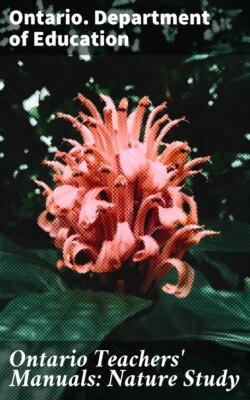Читать книгу Ontario Teachers' Manuals: Nature Study - Ontario. Department of Education - Страница 51
На сайте Литреса книга снята с продажи.
BUTTERFLY AND MOTH COLLECTIONS
ОглавлениеFor a study of the metamorphosis of butterflies and moths, it is necessary to have an insect cage. This can be purchased from any dealer in entomological supplies or it may be made by the pupils in the Manual Training Class. See Manual on Manual Training. A very satisfactory cage may be made, by the teacher or larger pupils, from a soap box, by tacking wire gauze over the open surface of the box, removing the nails from one of the boards of the bottom, and converting this board into a door by attaching it in its former position by light hinges and a hook and staple. The box, if now placed on end with two inches of loose soil in the bottom, will constitute a satisfactory insect cage, or vivarium.
A large lamp chimney with gauze tied over the upper end is useful for inclosing a small plant upon which eggs or insect larvæ are developing. The base of the chimney may be thrust an inch into the soil and the development of the larva as it feeds upon the growing plant can be studied.
The following are larvæ suitable for study and may be found in the places named:
The tomato worm on tomato or tobacco plants. (Look for stems whose leaves have been stripped off.)
The milkweed butterfly larvæ on milkweed,
The potato beetle on potato vines,
The eastern swallow-tail butterfly on parsnip or carrot plants,
The tussock-moth on horse-chestnuts,
The promothea moth on lilac bushes,
The cabbage-butterfly on cabbage or mustard plants,
The red-spotted purple, banded purple, and viceroy butterfly larvæ on willow and alder,
Cocoons of tussock-moth and tiger-moth under bark, logs, and rubbish in early autumn.
Larvæ of the emperor-moth (cecropia) may be found wandering about, apparently aimlessly, in September; but they are searching for suitable places for attaching their cocoons to orchard and forest trees.
After the leaves have fallen from shrubs and trees, cocoons can be found more easily on the naked twigs or in withered, rolled-up leaves that are fastened by the silk of the cocoon to the branches.
Larvæ, when placed in the cage, should be supplied with green plant food such as they were found feeding upon, and the pupils should be instructed to observe the chrysalis building or the cocoon weaving. It will be found that some larvæ burrow into the soil.
During winter the cage should be kept in a cool place, such as a shed, so that the winter conditions may be as nearly natural as possible.
In a few cases, the development within the cocoon is quite rapid; and the adult form hatches out in a few weeks, for example, the cabbage-butterfly, monarch or milkweed butterfly, and tussock-moth. For this reason these are preferable for study by Form I pupils. In April the cage should be placed in the school-room, that the pupils may observe the emergence of the insects and the spreading of the wings. The insects can be fed with syrup or honey until they are strong, then the pupils should set them free.
Reference.—Reports of the Entomological Society of Ontario, Department of Agriculture.
